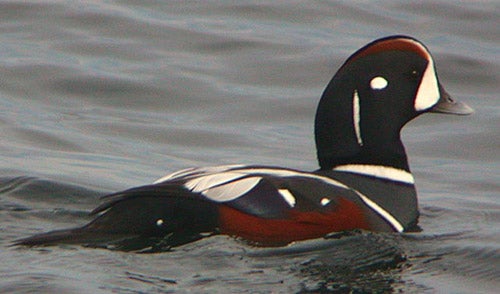SCIENTIFIC NAME:
Histrionicus histrionicus
STATUS:
Accidental.
DESCRIPTION:
Harlequin ducks (Histrionicus histrionicus) are medium sized sea ducks. Males are boldly marked. Their heads and bodies are slate blue, with reddish brown sides, and black rumps. Odd white patches and spots are present on their heads and bodies. Females are slate gray with two or three white spots on their head.
DISTRIBUTION:
Harlequin ducks are found along the east and west coast of North America. The summer range for the Pacific coast population extends from northeast Siberia, east to the Kamchatka Peninsula and the Commander Islands, north to the Arctic Circle, then across the Bering Sea to the Aleutian Islands. They are found inland through much of interior Alaska, and south to northwest Wyoming. The Atlantic coast population ranges from northern Quebec and Labrador to northern New Brunswick, and eastward to parts of Greenland and all of Iceland. Winter range for Pacific coast harlequins is from Alaska south to California, with some birds ranging west to Japan. Atlantic coast harlequins range from Newfoundland to New Jersey and east to parts of Greenland and Iceland during the winter.
HABITAT:
Harlequin ducks most commonly are found along rocky coastlines during the winter months, and inland along fast moving mountain streams and rivers in forested regions during the breeding season. Harlequin ducks belong to the group of waterfowl known as diving ducks or divers.
FEEDING HABITS:
As is the case with other species in this group, harlequin ducks forage by diving below the surface to feed on crustaceans, mollusks, aquatic insects and other invertebrates, along with fish caught on or near the bottom.
LIFE HISTORY:
Harlequin ducks are not known to mate until they are two years of age. Adults normally are paired when they leave the sea in early May heading to their interior breeding grounds. After reaching the breeding grounds, males will follow the female, walking along for an hour or more, as she searches the edges of islands or the banks of swift flowing rivers for an appropriate nesting site among rock crevices or under low shrubs. Nests consist of a thin layer of grass, occasionally mixed with a few dried twigs and leaves. They are lined with a heavy layer of white colored down. Eggs are laid at intervals of 2-4 days. Shortly after a female begins incubation, the male abandons the female and leaves the breeding grounds. Clutches of 3 to 9 pale creamy to pale buff colored eggs are incubated by the female for 28 to 29 days. Females typically leave their nest only once every 48 hours during the incubation period to rest and feed. Once they have hatched and are dry, the down covered ducklings leave the nest. Females lead them to isolated parts of a river or stream. A given family group may join with other females and their broods or with females that were unsuccessful in their nesting attempts. Fall migration in many instances is more a movement from interior breeding grounds to coastal areas throughout their range. The Atlantic coast population engages in a much more distinct southward migration than does the Pacific population.
REFERENCES:
Bellrose, Frank C. 1976. Ducks, Geese and Swans of North America. Stackpole Books, Harrisburg, PA 543 pp.
Collins, Henry Hill Jr. 1981. Complete Field Guide to North American Wildlife. Harper and Row, Publishers, Inc. New York, NY 714 pp.
Cornell Lab of Ornithology. http://www.birds.cornell.edu/AllAboutBirds/BirdGuide/Harlequin_Duck_dtl.html
AUTHOR:
Mitchell Marks, Wildlife Biologist, Alabama Division of Wildlife and Freshwater Fisheries






